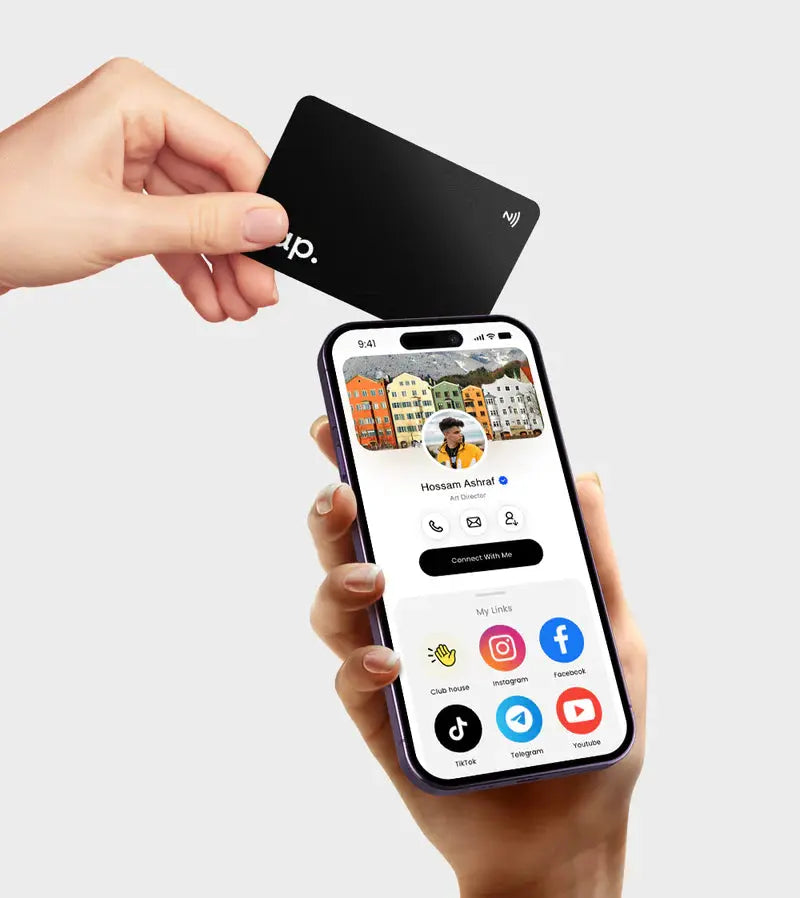Introduction to NFC: What It Is and Why It Matters in 2025
Estimated reading time: 6 minutes
Near Field Communication (NFC) technology is becoming an essential part of modern business and daily life. From NFC business cards that simplify networking, to NFC tags and chips embedded in everything from keychains to credit cards, this contactless communication method offers seamless, secure interactions with a simple tap.
🔄 What is NFC Technology and How Does It Work?
Near Field Communication (NFC) is a short-range wireless technology that enables the exchange of data between devices when they are close together. Operating at 13.56 MHz, it supports data transfer rates of up to 424 kbps and eliminates the need for manual pairing or data entry.
Its most well-known use is in contactless payments via services like Google Pay, Apple Pay, and Samsung Pay. But NFC goes far beyond that—enabling smart access control, sharing files, triggering apps, and interacting with smart posters or packaging.
📸 Suggested Image #1: A person paying with a phone using NFC
Alt text: Contactless NFC payment using smartphone
🏷️ NFC Tags: How They Work and What They’re Used For
NFC tags are small, programmable chips that can be embedded into almost anything—from marketing materials to product packaging. These tags store small amounts of data and can be read by any NFC-enabled device.
For example:
-
Posters with NFC tags can direct users to a landing page or app.
-
NFC stickers or NFC leather keychains can trigger specific actions like connecting to Wi-Fi or sharing contact info.
-
Retailers use NFC tags for smart product labeling, adding a layer of digital interaction to physical items.
📸 Suggested Image #2: An NFC tag embedded in a product label
Alt text: NFC tag integrated into product packaging for smart marketing
💼 NFC Business Cards: The Future of Networking
One of the most practical applications of NFC is the NFC business card. Unlike traditional cards that can get lost or become outdated, NFC cards allow users to instantly share:
- Contact info
- LinkedIn profiles
- Portfolios
- Calendly booking links
Just one tap, and your contact details are saved directly to someone’s phone.
These cards are dynamic—meaning you can update the data anytime without reprinting, making them sustainable and future-proof.
🔗 Book a Free Demo to see how Tap's NFC business cards can transform your team’s networking experience.
📸 Suggested Image #3: Hand tapping NFC business card on phone
Alt text: Sharing contact information via NFC business card
🔒 NFC Technology and Data Security
One of NFC's biggest strengths is security. The short range required (typically under 4 cm) reduces risk. Additionally, secure elements and encryption protocols—like tokenization in payment systems—protect user data.
In industries like finance and healthcare, where security is critical, NFC allows seamless yet protected data transfers. And since NFC doesn't require device pairing, it's faster and safer than Bluetooth in many cases.
📲 NFC in Everyday Life: Practical Applications
From public transportation cards to smart packaging, NFC is already deeply integrated into our lives. These chips are found in:
- Bank cards for tap-to-pay
- Hotel key cards
- Access badges for offices
- Smartwatches and fitness trackers
- Product packaging that connects customers to brand experiences
As discussed in Tap’s Digital Business Cards Evolution, NFC technology continues to grow—bringing businesses and customers closer with every tap.
📸 Suggested Image #4: Everyday products using NFC chips
Alt text: Multiple everyday items embedded with NFC technology
✅ Conclusion: Why NFC is More Than Just a Trend
NFC is not just about convenience—it's about connectivity, efficiency, and future-ready business solutions. Whether you're using it for secure payments or next-gen networking, NFC is a smart, scalable technology that helps you stay ahead in a digital world.
🎯 Ready to take your business digital with NFC?
👉 Book a Free Demo Now



Leave a comment
This site is protected by hCaptcha and the hCaptcha Privacy Policy and Terms of Service apply.